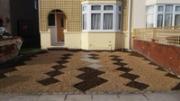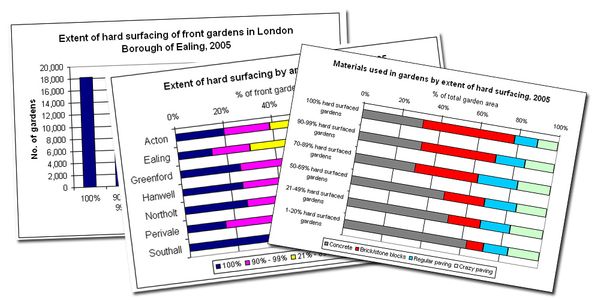
Over 74000 Front Gardens
There are an estimated 74,300 front gardens in the borough. Their total surface area is 3,052,000 square metres (m2). This is 5.5% of the total geographical area of the borough (55.37 square kilometres).
Nearly two-thirds - 64% or 1,961,000m2 - of the total front garden area is covered with hard surfacing of some kind. This is 3.5% of the total geographical area of the borough, and nearly one and a half times the size of Hyde Park in central London.
The Average Front Garden
The average front garden is 68% hard surfaced. But as the chart shows, this average hides a wide range.
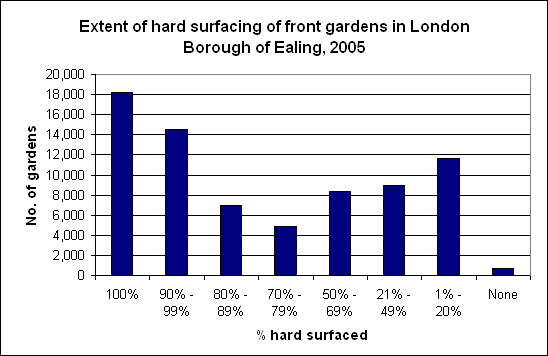
Front gardens that are completely hard surfaced account for 637,000m2 or a third of the total hard surfaced area. Front gardens that are 70% or more hard surfaced account for 1,547,000m2, or nearly 80% of the total.
Smaller front gardens are somewhat more likely than larger ones to be extensively hard surfaced, but there is a full range of degrees of hard surfacing in all sizes of garden. Area of the borough is a more important influence on the extent of hard surfacing. The chart shows that complete (100%) hard surfacing is particularly prevalent in Southall and least so in Ealing. Nevertheless, all areas of the borough also have 'traditional' less-than-20% hard surfaced front gardens.
Hard Surfacing Materials

The hard surfacing materials most often found in the borough's front gardens are concrete, bricks or stone blocks, and various types of paving. Concrete is the most widespread material, but in terms of square meterage, there is more brick/stone block surfacing than concrete (see chart).
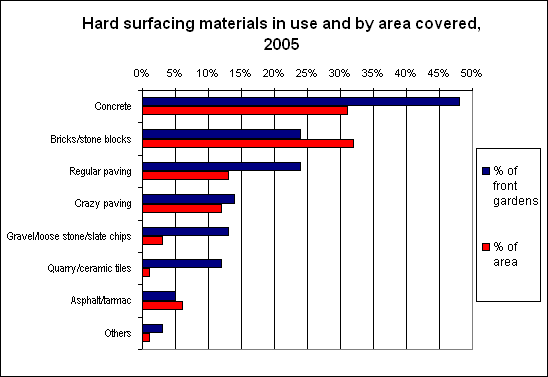
In addition, brick/stone block surfacing is much more common in front gardens which are extensively hard surfaced. In completely hard surfaced front gardens, 275,000m2 is covered by bricks/stone blocks, compared with 182,000m2 by concrete. In gardens which are nearly completely (90-99%) hard surfaced, there is 183,000m2 of brick/stone block surfacing, compared with 154,000m2 of concrete. Only in front gardens which are less than 70% hard surfaced that there is more concrete than brick or stone block surfacing (see chart below).
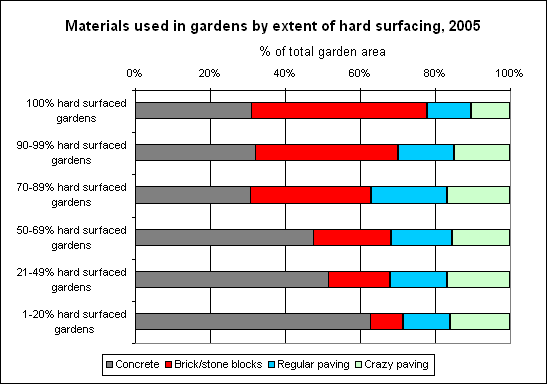
Brick or stone block surfacing has only become popular fairly recently. This suggests that there is a trend towards hard surfacing more of the front garden area than in the past.
Gardens Being Used for Parking
The main reason why front gardens are hard surfaced is for parking. Over 30,000 of the borough's front gardens are being used for parking one or more vehicles, on total of 1,279,000m2 of hard surfacing. The proportion of front gardens being used for parking varies by area of the borough. This is partly due to the sizes of the front gardens available for parking - in Hanwell the majority of front gardens are small, while in Greenford they are larger. Access to a range of public transport services is also likely to contribute.
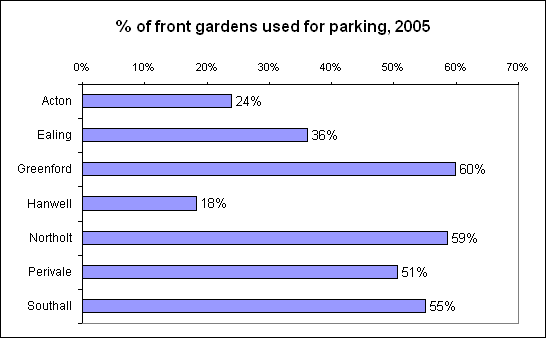
Having a garage does not save the front garden from parking. More properties with garages use the front garden for parking than do those without garages. (This is probably because properties with garages already have a pavement crossover and tend to have larger front gardens).
The front boundary structures of gardens - hedges, fences, walls, railings etc. - are casualties of front garden parking. Only a quarter of front gardens used for parking have all the front boundary structure in place, compared with 92% of those which are not used for parking.
But Not All Hard Surfacing is for Parking
Many people assume that parking is the reason why front gardens are extensively hard surfaced. However, this is not necessarily the case. 32,800 front gardens in the borough are completely or nearly completely (90+%) hard surfaced, but only 19,900 of these are likely to be being used for parking, leaving 12,600 - well over a third of them - which are not. This is not entirely explained by size of garden:
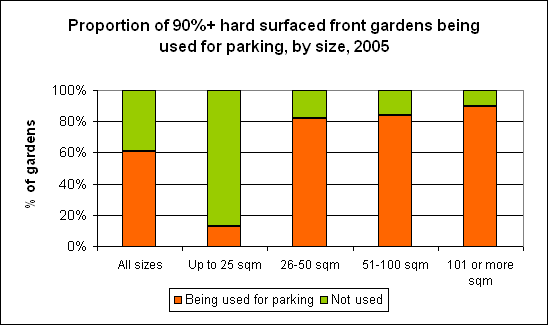
There are 3,000 front gardens of 26-50m2 and 700 over 50m2, all of which are 90% or more hard surfaced and yet not being used for parking. In Southall nearly half of the 6,300 front gardens not being used for parking are 90+% hard surfaced, a considerably higher proportion than elsewhere in the borough.
About Ealing
Ealing is the third largest London Borough. As well as Ealing, it includes Southall, Acton, Greenford, Hanwell, Northolt and Perivale. At the 2001 Census there were over 300,000 residents in 118,000 households and with over 140,000 cars/vans. Housing is a mix of Victorian, Edwardian, 1920s/30s and more recent development as the borough expanded westwards, following the railways. Many houses have small front gardens without garages and driveways.
